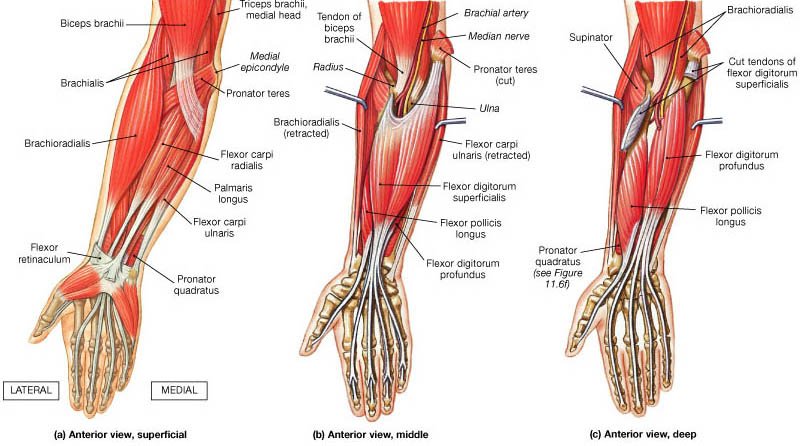Enhancing Forearm Muscles: Effective Training Techniques
Table of Content
Anatomy of Forearm Muscles
Flexor Muscles
Extensor Muscles
Functions of Forearm Muscles
Common Injuries
General Injuries
Gym-Related Injuries
Office Work-Related Injuries
Warm-Up Exercises
Effective Forearm Exercises
1. Wrist Curls
2. Reverse Wrist Curls
3. Farmer’s Walk
4. Hammer Curls
5. Plate Pinches
Cool-Down Routine
Conclusion
Forearm muscles are essential not only for athletic performance but also for various daily activities. Whether lifting weights at the gym, typing on a computer, or performing manual labor, strong forearm muscles contribute significantly to your overall strength and functionality. This article will delve into the anatomy of forearm muscles, their functions, common injuries, and effective training techniques, including warm-up exercises, workouts, and cool-down routines.
Anatomy of Forearm Muscles
The forearm consists of several muscles divided into two main groups: the flexors and the extensors.
Flexor Muscles
Flexor Carpi Radialis: Flexes the wrist and aids in radial deviation.
Flexor Carpi Ulnaris: Flexes the wrist and aids in ulnar deviation.
Palmaris Longus: Flexes the wrist, although not everyone has this muscle.
Flexor Digitorum Superficialis: Flexes the fingers and wrist.
Flexor Digitorum Profundus: Flexes the distal joints of the fingers.
Extensor Muscles
Extensor Carpi Radialis Longus: Extends the wrist and aids in radial deviation.
Extensor Carpi Radialis Brevis: Extends and abducts the wrist.
Extensor Carpi Ulnaris: Extends the wrist and aids in ulnar deviation.
Extensor Digitorum: Extends the fingers and the wrist.
Extensor Indicis: Extends the index finger.
Functions of Forearm Muscles
Forearm muscles are essential for:
Grip Strength: Crucial for lifting, holding, and manipulating objects.
Wrist Movement: Necessary for flexion, extension, and deviation.
Finger Movements: Important for fine motor skills and dexterity.
Forearm Rotation: Allows pronation (turning the palm down) and supination (turning the palm up).
Common Injuries
Forearm injuries can occur due to various activities, including sports, weightlifting, and even office work. Understanding these injuries can help in preventing and managing them effectively.
General Injuries
Tendonitis: Inflammation of tendons due to overuse.
Muscle Strain: Overstretching or tearing of muscle fibers.
Compartment Syndrome: Increased pressure within the muscles, leading to pain and swelling.
Gym-Related Injuries
Tennis Elbow (Lateral Epicondylitis): Pain on the outer part of the elbow due to repetitive stress.
Golfer’s Elbow (Medial Epicondylitis): Pain on the inner part of the elbow from overuse.
Wrist Sprains: Ligament injuries due to excessive force or improper technique.
Office Work-Related Injuries
Carpal Tunnel Syndrome: Compression of the median nerve causing pain, numbness, and tingling in the hand and arm.
Repetitive Strain Injury (RSI): Overuse injury from repetitive motions, such as typing or using a mouse.
De Quervain's Tenosynovitis: Inflammation of the tendons on the thumb side of the wrist due to repetitive motion.
Warm-Up Exercises
A proper warm-up increases blood flow to the muscles, enhancing flexibility and reducing injury risk. Spend at least 10 minutes warming up before working out.
Wrist Circles: Rotate your wrists in clockwise and counterclockwise directions for 1-2 minutes.
Finger Flexor Stretch: Extend your arm, palm up, and gently pull your fingers back with your other hand.
Forearm Extensor Stretch: Extend your arm, palm down, and gently pull your fingers back.
Light Resistance Bands: Use a light resistance band to perform wrist flexions and extensions.
Effective Forearm Exercises
Incorporate these exercises into your routine to build strong and well-defined forearm muscles.
1. Wrist Curls
Target: Flexor muscles.
Execution: Sit on a bench, hold a dumbbell in each hand with palms facing up. Rest your forearms on your thighs, curl the dumbbells up and down.
Sets/Reps: 3 sets of 12-15 reps.
2. Reverse Wrist Curls
Target: Extensor muscles.
Execution: Similar to wrist curls but with palms facing down.
Sets/Reps: 3 sets of 12-15 reps.
3. Farmer’s Walk
Target: Grip strength and overall forearm muscles.
Execution: Hold a heavy dumbbell or kettlebell in each hand and walk for a set distance or time.
Sets/Reps: 3 sets of 30-60 seconds.
4. Hammer Curls
Target: Brachioradialis and brachialis.
Execution: Hold a dumbbell in each hand with a neutral grip (palms facing each other) and curl the weights up.
Sets/Reps: 3 sets of 10-12 reps.
5. Plate Pinches
Target: Pinch grip strength.
Execution: Hold two weight plates together with your fingers and thumb, keeping them pinched together.
Sets/Reps: 3 sets of 30-60 seconds.
Cool-Down Routine
Cooling down helps to gradually reduce the heart rate and stretch out the muscles to prevent stiffness.
Wrist Flexor Stretch: Hold each stretch for 20-30 seconds.
Wrist Extensor Stretch: Similar duration as the flexor stretch.
Forearm Massage: Use a foam roller or your hands to massage the forearm muscles.
Light Cardiovascular Activity: A few minutes of light jogging or walking to gradually lower heart rate.
Conclusion
Enhancing your forearm muscles requires a combination of proper warm-ups, targeted exercises, and effective cool-down routines. Understanding the anatomy and function of these muscles can help you prevent injuries and achieve better results in both everyday tasks and athletic endeavors. Incorporate these techniques into your fitness routine to build stronger, more resilient forearms.


